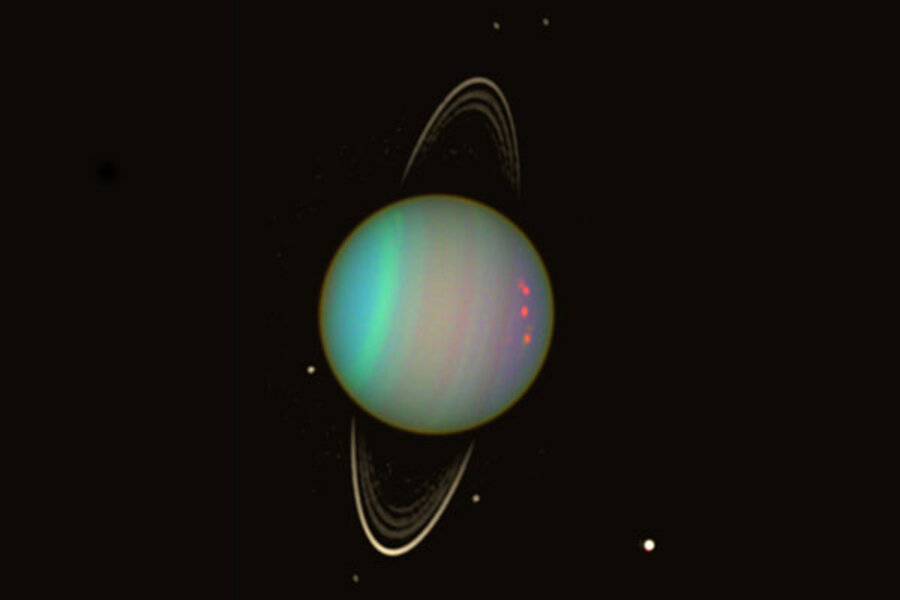What's that thing in Uranus's orbit – and how did it get there?
Loading...
The planet Uranus – already an odd duck for its upended rings and spin axis that means it is spinning on its side – is being chased by two asteroids and is chasing another. One of the asteroids is in an unexpected orbit, by some estimates
As a group, the trio presents a puzzle, because these co-orbiting objects are far fewer than those found orbiting with two other gas giants, Neptune and Jupiter, according to a new study. Some calculations have suggested Uranus shouldn't have any at all.
Solving that riddle could yield additional insights into processes that took place early in the solar system's history as well as test ideas about the evolution of the motions of solar system objects humans see today, notes Scott Kenyon, a researcher at the Harvard-Smithsonian Center for Astrophysics whose work focuses on star and solar-system formation.
Depending on the objects' composition and orbital traits, asteroids co-orbiting a planet could represent building blocks left over from the formation of the planet itself, or they may have migrated from somewhere else, only to occupy their current orbits until something disturbs their trajectory and they move on.
The asteroids co-orbiting Uranus belong to a class known as Centaurs. Centaurs, discovered in the 1920s, tend to orbit among the outer planets – those beyond Mars. They represent a cross between asteroids and comets, with two showing halos of gas similar to a comet's coma. By some estimates, the solar system hosts 44,000 of these objects larger than 1 kilometer (0.6 miles) across. The largest is 260 km (160 miles) wide and orbits between Saturn and Uranus.
Two of the three objects co-orbiting Uranus were discovered between 2002 and 2010. A team of Canadian and French astronomers reported the discovery of the third in March.
Of the three objects, 83982 Crantor was the target of the new study, conducted by researchers Carlos and Raul de la Fuente Marcos at The Complutense University in Madrid.
The object turns out to be one of the ruddiest bodies in the solar system – its reddish hue suggesting the presence of hydrocarbon particles known as tholins, similar to those on Saturn's moon Titan. In addition, 83982 Crantor appears to have water ice and methanol on its surface.
The two researchers were particularly interested in the object's orbit. After running their calculations, the scientists found that, as seen from Uranus's orbital path, 83982 Crantor appears to trace an enormous corkscrew pattern during its travels. When the orbit of this 41-mile wide object is traced relative to the sun and Uranus, it takes on the appearance of loop bent into the shape of a giant horse shoe, rather than forming an ellipse.
The odd shape results from changes in the asteroid's acceleration as it travels. The orbit is “controlled by the sun and Uranus but is unstable due to disturbances from nearby Saturn,” said Carlos de la Fuente Marcos in a prepared statement. It's the close encounters with Uranus, however, that affect the orbit in ways that make it appear as a horse shoe along a path in which the asteroid appears to catch up with, then lag the planet.
In 2006, Uruguayan astronomer Tabaré Gallardo suggested that 83982 Crantor had the same orbital period Uranus did. But another pair of scientists calculated that Uranus was incapable of attracting and holding – even temporarily – anything in an orbit that would share the planet's orbital period. That would help explain the paucity of co-orbiting objects that are far more abundant with Neptune and Jupiter.
But the calculations by the de la Fuente Marcoses indicate that Dr. Gallardo was correct. Indeed, the object reported by the Canadian and French team in March also appears to be co-orbiting with the same orbital period Uranus has – caught in a gravitational sweet spot between Uranus and the sun stable enough to maintain the asteroid's relative position ahead of Uranus throughout their orbits.
Indeed, the de la Fuente Marcoses suggest 83982 Crantor could represent "a Rosetta Stone" for solving the mystery of outer-planet co-orbiting asteroids.
The duo's calculations also suggest that the 83982 Crantor is a transitory object on cosmic timescales, not one that is part of the debris left over from Uranus's formation.







